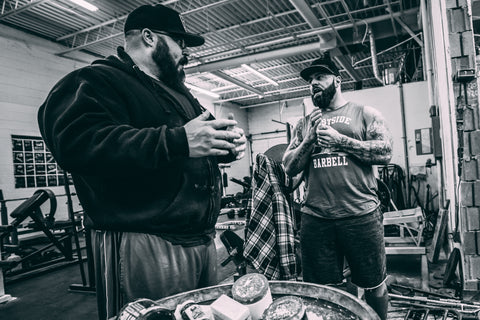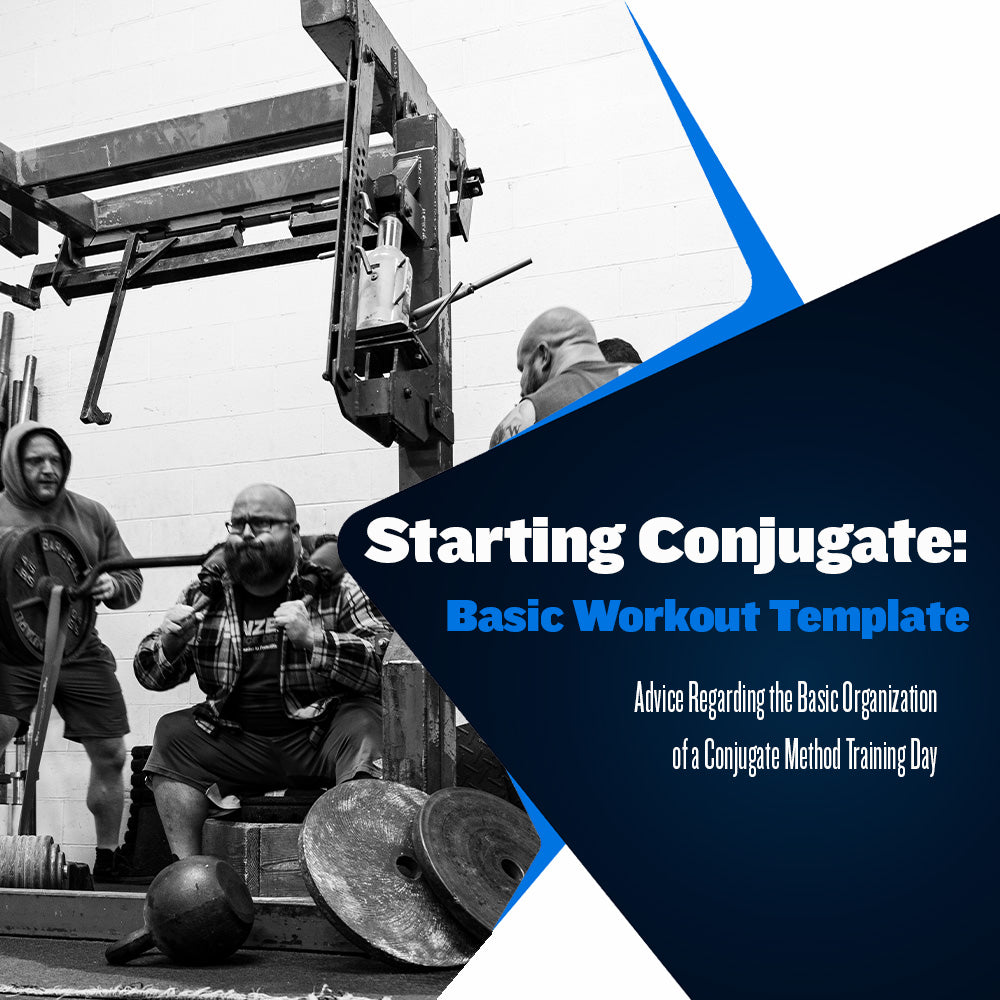Starting Conjugate: Basic Workout Template

As we have discussed previously, your success using the Conjugate Method will depend significantly on the quality of your programming. To be successful, an athlete must have a properly scheduled training week, and within that week, athletes must appropriately organize each training day.
As an athlete new to the Conjugate Method, it is vital that you understand how to organize your training days properly. The organization of the training week is simple; max-effort lower on Monday, max-effort upper on Wednesday, dynamic-effort lower on Friday, and dynamic-effort upper on Saturday. You don’t have to train on those exact days, but you must maintain the timespan between each training day for recovery to remain optimal.
The organization of a training day is relatively easy to understand but requires some explanation to ensure exercises are performed in the correct order. Correctly organizing your exercises is important to ensure energy levels are advantageously managed throughout the training session. The idea is to schedule exercises to provide the most energy to the most demanding exercises.
Energy management is critical, both from a performance and safety aspect. Having your workout scheduled correctly will allow you to perform the exercises to the correct standard and have enough energy to maintain proper form during the most intense part of your training day.
Here is the basic workout template we follow at Westside Barbell each training day:
Warm-Up
Getting warmed up is always the first step to any successful training day. No matter how gifted an athlete is, workout quality always improves with a proper warm-up routine. The issue is knowing the difference between warming up and wasting energy.
The idea of a warm-up is simple; get blood moving and mobilize. If we are going to squat or deadlift, we will perform exercises such as KB swings, standing abs, Reverse Hypers, or belt squats. On a bench day, we will perform exercises like dumbbell presses, tricep press downs, face pulls, and Y raises.
These exercises are performed using light weights for 2-4 light weight, high rep sets. It is important to know the difference between warming up and training. As stated above, we want to get some blood moving and mobilize the joints. A proper warm-up should achieve this goal without taking hardly anything away from energy reserves.
Main Exercise
The main exercise of the day is the focus of each training day. This exercise focuses on the specific special strength we are training that training day. Our main exercise focuses on developing absolute strength if it is a max-effort day or developing speed strength on a dynamic-effort day.
No matter which strength we are focusing on, the main exercise is the exercise we will spend the most energy performing. The goal is to execute each method with the proper intent, moving the heaviest weight we can, or moving submaximal weights as fast as we can. Regardless of which method is performed, both require significant energy to execute appropriately.
Athletes will typically perform a max-effort main exercise for 1-3 repetitions. We work up to a top set, where we lift the heaviest weight for that training day on the final set. A dynamic effort main exercise will be performed for multiple sets and reps and will escalate over a three-week training wave. Either way, you need energy reserves to be near full to execute your main exercise properly.
Accessory Exercises
One common misconception about our methods is that a Conjugate Method program lacks volume. This couldn’t be further from the truth. You may have heard of the 80/20 rule, which states that 80% of our training volume is accomplished during our accessory training. We use main exercises to improve special strengths directly. In contrast, we use accessory exercises to focus on hypertrophy and improving weaknesses found during the main exercises to continue making progress.
It’s a simple idea; the main exercise reveals weaknesses or technical issues, and the accessory exercises address these weaknesses by improving strength and building additional muscle. With this strategy, a lifter will become bigger, stronger, and more resilient. Knowing how to analyze your training data and create an accessory program that addresses known issues is the ticket to continuous PR lifts.
Having your accessory exercises scheduled in the correct order is also essential. Typically, our training days will include a primary accessory exercise. This movement will be a multi-joint movement that could be used as the main exercise, except we perform this exercise for multiple sets and reps. For instance, we may perform a close grip bench press for four sets of 5-8 repetitions as a primary accessory exercise if the triceps and upper back are a significant weakness.
The remaining accessory exercise selection will be a mix of multi-joint and single-joint movements. We typically organize these exercises so that multi-joint exercises are performed first while single-joint exercises follow. We do this to ensure demanding accessory movements are performed with as much energy in reserve as possible.
Each training day will feature 3-6 total accessory exercises. The amount of exercises scheduled depends on how much energy you have in reserve, how demanding your last training day was, and how demanding your next training day will be. We want to perform as much accessory work as possible while ensuring we are leaving room for recovery so that the next training day is successful.
If you constantly perform high-volume sessions, you will become a victim of fatigue and either injure yourself or require a deload period so that training can continue. Be conscious of your physical state before, during, and after each training session, and use this information to program your next training session.
It is important to note we do not typically assign percentages to accessory exercises. We do this because it is difficult to judge how much energy an athlete will have after the main exercise. Our rule of thumb is simple, perform each accessory exercise using the heaviest weight you can while performing all prescribed sets and reps with proper technique.
Be honest with your weight selections. Avoid laziness. Push yourself, but don’t destroy yourself.
General Physical Preparedness
At Westside, we typically end each day with GPP training. This work should be taxing but easy to recover from afterwards. The idea is to use exercises such as sled pulls, sled pushes, wheelbarrow walks, yoke walks, and farmer’s walks to improve overall conditioning and general fitness.
No matter which option you choose, you want to load the implement with enough weight to make the training worthwhile, but not so much that you must exert high levels of force to accomplish the exercise.
Ideally, we want to find a weight that allows us to add to the overall training volume while improving cardiovascular capacity. Just don’t turn your GPP training into a CrossFit Games event.
Putting It All Together
The Westside Barbell Basic Workout Template:
Exercise A - Main Exercise (ME = 1-3 reps, DE = multiple reps/sets)
Exercise B - Multi-Joint Primary Accessory Exercise (3-4 sets, 3-5 reps or 5-8 reps)
Exercise C (optional) - Multi-Joint Accessory Exercise (3-4 sets, 5-8 reps)
Exercise D - Single-Joint Accessory Exercise (3-5 sets, 10-12 reps)
Exercise E (optional) - Single-Joint Accessory Exercise (3-5 sets, 10-12 reps)
Exercise F - Single-Joint Accessory Exercise (3 sets, 15-20 reps)
Exercise G (optional) - Single-Joint Accessory Exercise (3 sets 15-20 reps)
Exercise H - GPP Training
For more information regarding the Conjugate Method, check out the Westside Barbell blog.
Sources:
Simmons, L. (2007). Westside Barbell Book of Methods. Westside Barbell.
Verkhoshansky, Y., & Siff, M. C. (2009). Supertraining. Verkhoshansky.





